Header bidding. It seems like every other week there’s a new header bidding solution on the market. Between Prebid, Index Exchange, and more, it can be hard to know which one is right for your site. Since the onset of real-time bidding, header bidding technology has been the biggest breakthrough in the programmatic ad buying world. In this guide, we break down everything you need to know about header bidding so you can make an informed decision.
We cover what header bidding is, header bidding history, how it works, the whole header bidding process and the pros and cons of using it. Plus, we give you tips on how to get started with header bidding in 2023 if you decide to give it a try. So what are you waiting for? Read on!
The term header bidding has been around for a few years now with Google Trends shows that the term sprung onto the scene in the summer of 2015, but only recently publishers have been using the technology as a serious piece of their ad management tech stack.
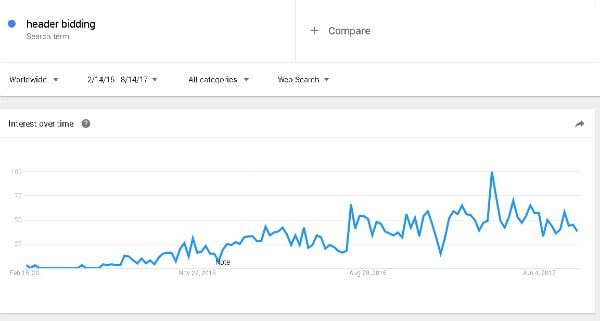
With Digiday reporting that Sizmek found 60% of the top 30,000 websites are using header bidding vendor tags on their pages. The biggest benefit of header bidding is that it helps publishers get higher header auction rates for their unsold inventory with established publishers like The Telegraph claiming to have increased their programmatic revenues by 70% with their implementation of header bidding.
Clearly, there can be enormous revenue uplift benefits for publishers to move away from the waterfall auction and into header bidding. Though as publishers embrace header bidding they’re finding the drawbacks of an Open-Source Header Bidding Wrapper like the Prebid wrapper and are moving to more sophisticated setups to battle page latency, brand safety, revenue discrepancy, etc.
For a publisher of that size and traffic to increase programmatic earnings by 70% is staggering! Although not every publisher might see such dramatic increases, a lift in earnings is imminent when implementing header bidding, especially through MonetizeMore.
However, this technology is not without its challenges, and as usual, many publishers struggle to understand the header auction process, implementation of header bidding, and everything that goes with it. With so many companies offering header bidding services apart from the open-source solutions available on the market, it is often hard to cut through all the noise.
Whether you’re an up-and-coming publisher trying to maximize their earnings or a premium publisher with millions of visitors, knowing the A-Z of header bidding in 2023 and what is header bidding in digital marketing is a must!
Let’s get started!
What is Header Bidding in digital marketing: Header Bidding vs Waterfall

In simple terms, the definition for header bidding aka pre-bid is: A programmatic technology publishers use to get the most out of their premium inventory and ensure that the highest paying bid is served.
Now let’s go back to header bidding history here. Before header bidding was a staple to many publishers, many were utilizing the waterfall bidding aka daisy-chaining structure. Now you must be wondering ‘what is waterfall model in programmatic advertising?’
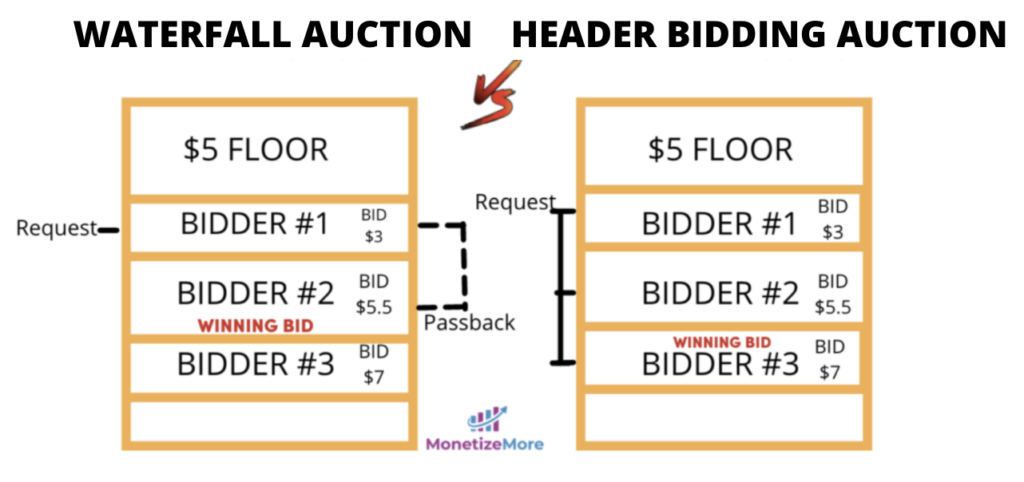
What is a waterfall bid?
In waterfall setups or waterfall auction, once the pricing floor threshold is met (usually the second-price auction is the winning bid), bidding for your RTB inventory stops. Your RTB Inventory is sold to a lower-yield bidder with higher priority (For example: the second-highest bidder wins). The sequence also requires a lot of tweaking to optimize for the best yield while minimizing latency.
The waterfall auction model is also known as the second-price auction model. With the programmatic watefall approach, publishers would manage their demand partners by ordering them from highest to lowest waterfall bids. Waterfall bidding, however, comes with a few challenges that header bidding thankfully solves.
Header Bidding History | Issues with the Programmatic Waterfall Model
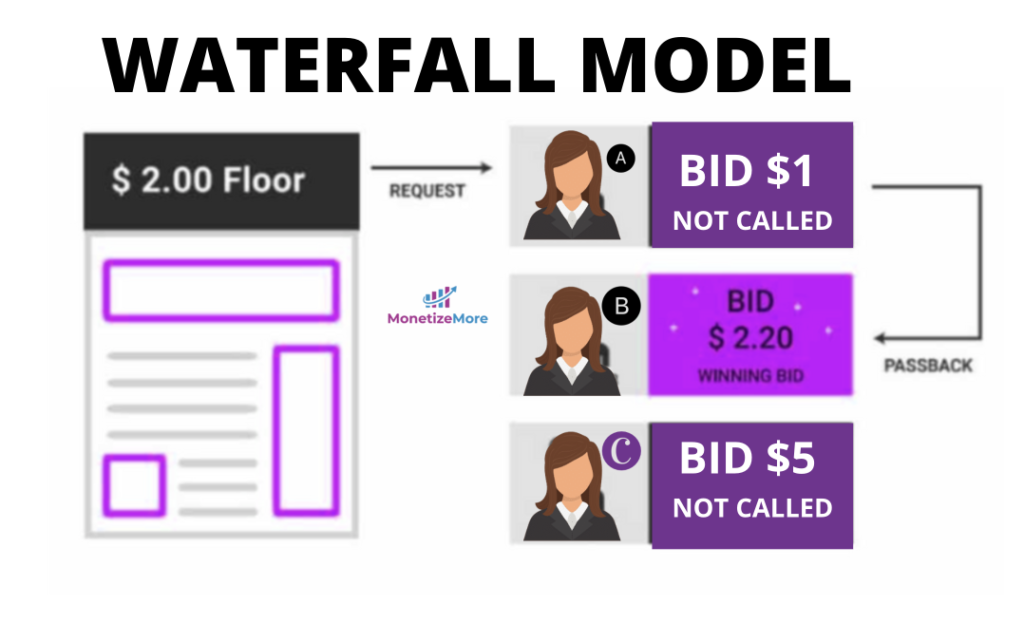
The reason why the waterfall bidding or the daisy-chain system was replaced was the price your impression sells for barely even accounts for its real value.
In the waterfall auction, unsold inventory is put forward to the top-ranked ad exchange, based on size, rather than to the highest bidder. If nobody in that tier bids here, it gets passed down to the 2nd tier and the cycle continues until an advertiser bids for it during that bidding time.
Yield risk: With the traditional programmatic waterfall model, the publisher ad server picked partners to serve impressions based on their average historical yield. However, this variable is known to be a bad predictor of what an ad impression is worth. Platforms like Google Ad Exchange with its DFP connection that can bid impression by impression also get an unfair advantage. It resulted in publishers managing their ad inventory not based on the real value, but an assumption of what an impression was worth.
Fill risk: The publisher ad server would often serve ad impressions to exchange with the highest average rate, but sometimes the exchange couldn’t fill those impressions. It also requires the publisher to have a plan B in place if they want to sell the impression at all. The plan B could be to call out to another exchange or to pass back to their primary ad server for the second round of ad decisions where the whole header-auction process might repeat itself. Publishers need to know if they can fill their ad impressions before they call the exchanges which they can’t with the waterfall structure.
Passback issues: Because of the complexity of the Google waterfall method, publishers are faced with a challenging and time-intensive task of managing, waterfall optimization, and reporting. Typically they need an ad operations team with access to multiple platforms and a lot of time to handle the setup. In reality, the publishers’ marketplace is chaotic in the waterfall bidding process as it is not automated.
How head bidding solves waterfall bidding issues:
With header bidding, publishers have the option to move past the ‘what is waterfall optimization’ challenges phase and integrate with multiple programmatic companies. Header bidding begins once the site begins to load on the users’ browser.
To solve yield risk header bidding allows the publisher to understand the value of an impression in advance before making the ad serving decision.
Publishers can know what each impression is worth to multiple exchanges at once instead of relying on an average rate that is unreliable. This means the highest bidder wins this programmatic auction and the publisher earns more.
With header bidding, publishers get real bid values which also solves the issue of fill risk. The publisher has a bid, or it doesn’t and therefore knows whether the exchange will deliver a bid or not. Header bidding has an immediate revenue effect on the publisher because they understand what the market will pay without losing any impressions. It is also a form of dynamic allocation for third-party ad networks.
Here’s our video describing this process in more detail below:
How does header bidding work? [Header Bidding explained]
The average website page includes a few elements and different locations where ads can be placed such as the sidebar, footer, etc. The header area on the page is essentially an invisible area at the top where information on styling and other elements get stored such as the CSS file, Javascript, and so forth.
A publisher would implement header bidding via ad tech partners or using their in-house development team to create a custom solution for them. The publisher would place a piece of additional Javascript code within the head of their web page. The header location of the page is where header bidding gets executed even before the web page gets loaded and presents the website visitor with content and advertisements.
An example would be as follows: A visitor visits Forbes.com, and within a few milliseconds the header bidding code gets executed, makes a call to the demand partners the publisher is signed up with (AppNexus, etc.) and gets them to place a bid. The winning bid is decided between all the available demand-side platforms, and the highest bidding is selected.
That information is passed directly to the publisher’s ad server. Within the primary ad server, based on how the publisher has set up their system, header bidding partners will compete against all other sources of demand. Once the overall highest bid is selected the ad gets displayed on the publisher’s website, and the publisher enjoys the maximum yield for their website impressions.
There are barely any reporting discrepancies since it’s one single auction with sequential chaining.
Publishers can control which sources are allowed to bid in header bidding, which means all demand-side platforms in these simultaneous auctions. They have full control over increasing the floor price they charge for premium inventory.
Head over to PubGuru.com for a detailed explainer video and Prebid documentation resources on how header bidding works.
What is the main benefit of header bidding | Is Header Bidding good for publishers?

Header bidding is beneficial for both publishers and buyers/advertisers with the focus being on publishers. So, what are the advantages of header bidding?
Some of the benefits for publishers include:
Increased competition: Advertisers/demand partners can bid on every impression on the website increasing competition and giving them access to higher quality premium ad inventories. The increased competition also means an increase in bid prices and higher earnings for publishers. The floor price plays a significant role for the publishers who are simultaneously running both private auctions & open auctions.
More demand partners: With header bidding, publishers can integrate and get access to advertisers from multiple demand sources, similar to the point mentioned above, and most of the time results in a higher yield.
Increased transparency: Almost any business loves transparency, and that’s exactly what a publisher is. He/she is a person running a digital advertising monetized business. With header bidding, publishers are back in the driving seat with control to optimize their ad stacks a lot better than with traditional setups. Bid transparency is possible since publishers can sell ad space on an impression basis and see how much they were worth.
No more need for passback: A publisher does not need to push inventory back and forth as with traditional waterfall setups. It decreases the wastefulness of lost impressions and reduces latency.
Maximum Ad Revenue for Publisher Inventory: MonetizeMore has been able to grow its publishers’ ad revenue by 36%. Making your ad inventory and even video inventory pop out to a bunch of advertisers is the pathway to driving better CPMs and revenue growth. Increased ad revenue benefits publishers when their main aim is monetizing more of their premium inventory,
Better Yield: Since you are not solely relying on a single SSP, this allows smoother dynamic allocation of ad impressions & increased fill rate. You can sell your ad space on a per-impression basis easily.
How does Header Bidding help advertisers?
The benefits of Header Bidding for advertisers are as follows:
Increased inventory for advertisers: Buyers can now via header bidding get access to all of the publisher’s ad inventory regardless of them using AdX or not. This means the potential for accessing more audiences and with that reaching their campaign goals exist. It also means that there is more data available for DSPs which can further be used to improve advertising campaign results.
Improved forecasting: It’s great to be able to generate accurate forecasts. With header bidding, better forecasting is imminent for buyers since they have access to more constant inventory over longer periods of time.
Transparency: Media buyers can check out the publisher’s impressions & others stats directly from the source before programmatic ad buying.
What are header bidding wrappers?

Originally big industry names like Amazon, Criteo and a few other opened the market to header bidding with their header bidding products. Similar to what is needed today, a publisher would implement the code in the header, connect to DFP and benefit from the increase in ad revenue for publishers.
The issue with this approach was however that most of these solutions only allowed one source of demand for the publisher.
To increase competition within demand partners a publisher typically needed to set up multiple header bidding solutions to run more demand sources.
This meant more work in DFP with new creatives, line items and so forth needing the be created and managed.
It was also a very cumbersome process for publishers, which many could not afford to implement and as you can imagine, the effects on website speed weren’t all that great either.
Header bidding wrappers were introduced to solve this issue. With a header bid wrapper, a publisher can integrate multiple demand sources within the head of their web page.
No more additional individual setups were needed which saves the publisher a lot of effort, time and money.
Using the combined header code publishers can run multiple header bidding partners simultaneously and fully enjoy the benefits that go with it such as mentioned in the benefits section above.
With wrappers, the issue of site speed also should get solved. Currently, there are multiple header bidding wrappers available on the market with a mix of ad tech company developed and open source solutions.
Open source solutions include the likes of Prebid.js and PubFood.js, while ad tech solutions include MonetizeMore’s very own PubGuru and much more. Although the process a publisher understands is fairly simple you still need a skilled in-house team or ad tech company to help with header bidding implementations and monthly upkeep.
Related Read: https://www.monetizemore.com/blog/how-to-debug-your-header-bidding-setup/
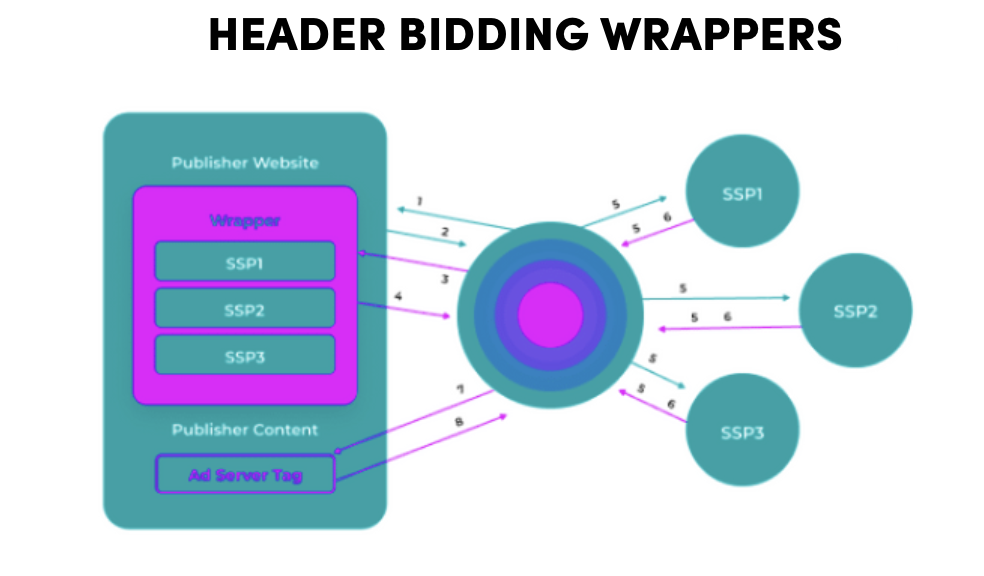
What is prebid programmatic?
Prebid.js aka the popular wrapper is one of the best header bidding wrappers out there.
Publishers can easily install line items through Prebid.js & control several ad calls with an ad server.
Pros and cons of prebid bidders
The Good:
- Prebid wrappers are free & open source.
- Improved speed while running header bidding auctions compared to waterfall auctions.
- User community that contributes to the code and provides support
The Bad:
- The prebid documentation is complex & maintenance can get convoluted at times.
- Prebid.js does require expert ad networks to install and run.
- The header bidding wrapper can slow down the loading speed of a website due to the innate overhead associated with its use.
Header Bidding vs Google AdSense
Simply said, Google AdSense is Walmart compared to Header Bidding that is Chanel. With Google’s market share falling compared to its’ fiercely competitive advertising partners, header bidding’s popularity is the reason for the switch.
You can integrate Google AdSense into header bidding, but this system allows you to astronomically extend the range of ad exchanges that will be able to bid on your inventory. More ad spend is flowing through the publishers’ marketplace as well.
How to implement header bidding

This will be a short introductory overview of the process of implementation since it can be somewhat technical. For implementation advice about your specific setup and needs, I urge you to get in touch with our team here.
For header bidding to work in the real-time auction environment, you need demand sources to compete against each other and open up your inventory to more buyers. It is fundamental to build and have solid partnerships with the likes of SSPs or Exchanges.
The list of header bidding partners are long and can include companies like AppNexus, Rubicon, Criteo, Amazon and more.
Timeouts need to be managed by publishers since multiple RTB auctions are taking place all at once for all the demand sources to produce their highest bid for the impression at hand. This takes time and can increase latency.
Overall it’s recommended keeping timeout durations within 500 milliseconds. Publishers need to make sure that a demand source or multiple sources aren’t delaying the header bidding programmatic auction and decreasing page load time.
Ad server configuration is also a very important step and as you can imagine your ad server, whether it’s DFP or something else, needs to be configured to support your header bidding solution.
For a detailed breakdown of how to implement header bidding, we put together this page explaining the benefits of Prebid’s open-source technology.
Related Read: https://www.monetizemore.com/blog/how-implement-header-bidding-advancedads-wordpress/
Google’s alternative: Exchange Bidding Google
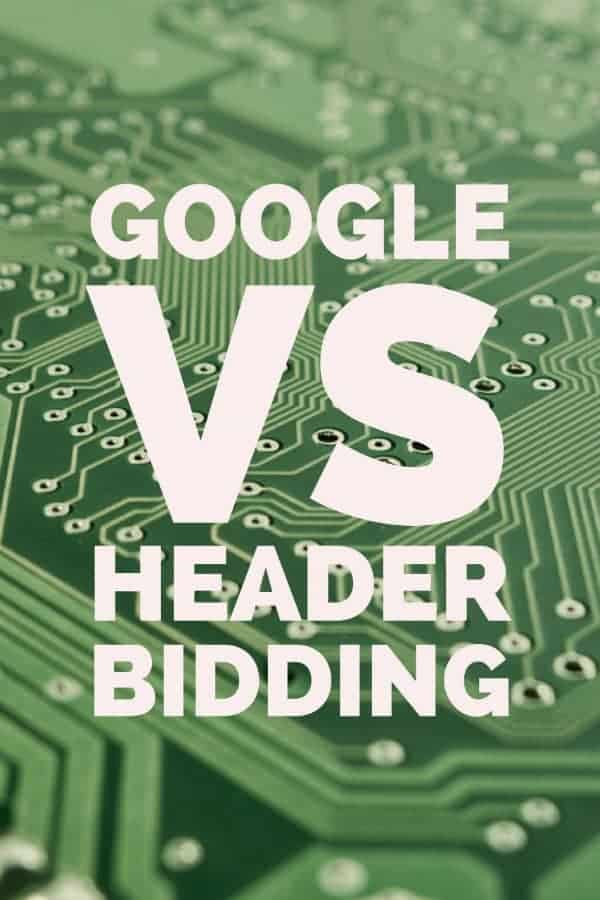
You might ask where does Google fit in all this? Well, Google has been testing and developing their solution or competing product you might call it towards header bidding. It’s called Exchange Bidding, and according to Martechtoday.com, this product has recently been opened to publishers, currently in Beta, via DFP.
Many premium publishers, totaling more than 100, including the likes of Zillow, MailOnline and more have been testing Exchange Bidding while exchanges such as OpenX also are participating and competing against DFP and Ad Exchange campaigns via a unified auction process.
Instead of being set up on the publisher’s website and running in the header code like header bidding, exchange bidding aka server-side header bidding runs on the server side which comes with many benefits.
These include much fewer implementation complexities and time needed, faster page loading/less latency and it also helps keep billing and reporting all in one location.
Google reported that those within the program have been seeing generous overall lifts in revenue and increased bidding times.
Since header bidding is such a hot topic within the programmatic community right now, Adexchanger also chimed in on the Google Header Bidding topic concluding that publishers should test Exchange bidding and header bidding, compare results and gain as much benefit from each solution. Such is their recommendation, at least for the time being.
Within their community of contacts, Adexchanger also reported that publishers agreed that Exchange bidding was a breeze to set up with the process taking less than 24 hours to implement where some, and keep in mind some not all, header bidding solutions are way more complicated and labor intensive.
Earlier I mentioned that the industry standard for header bidding is 500 milliseconds. Google claims to have brought their Exchange bidding process down to 60 milliseconds, however, not all publishers were experiencing these times on a consistent basis.
Apart from implementation and speed, the yield is, of course, a crucial factor for publishers. As mentioned Google indicated that its publishers in the beta program saw an increase in revenues. Adexchanger reported that results for publishers did vary, but that there was an additional list of money saving factors to using Exchange Bidding as well.
Keep in mind that Google will ask a percentage based fee for using Exchange Bidding and that their product is far from perfect at the moment. Even though Google’s Exchange Bidding is a nice addition to the market, it has not yet surpassed header bidding and might not for a while. However, within the programmatic industry, it’s always good to keep an eye out for developments and changes that can benefit you and your business.
What is the difference between header bidding and open bidding?
The goal of header bidding was to add competition to Google Ad Exchange or Google AdX, allowing bidders to preview auctions & win impressions they valued by bidding one cent more than the winning bid.
All demand partners and header bidding partners now bid on the impression simultaneously, giving Google less control over the process.
Google then offered its own bidding model, Open Bidding which was earlier known as Exchange Bidding or EBDA where real-time auctions happen on the ad server.
In Open Bidding, server-to-server connections are used, which are faster than page tags, resulting in a reduction in page latency and increase in ad viewability and greater yield. This is somewhat a Google AdX privilege for Open Bidding partners.
Google AdX Privilege Takeaways:
- Boost in site speed.
- 30-40% revenue boost & increased CPM rates.
- Bidding time optimization.
Header Bidding vs Open Bidding (EBDA)
Compared to Google’s Open Bidding, Header Bidding’s setup & user interface is more complicated. However, publishers have more freedom with header bidding.
Furthermore, the auction takes place on an ad server instead of in the user’s browser, which means that Open Bidding has significantly reduced latency compared to header bidding.
Header Bidding is more transparent compared to Open Bidding as publishers will never know why a certain advertiser won the bid in Open Bidding.
When it comes to better match rates for cookies, header bidding wins the game here where cookie syncing permits easy data exchange while matching users with their respective profiles on the programmatic media buying database.
Header Bidding trends for 2023 and beyond

Let’s take a quick look at some of the forecasts for header bidding now and the years to come.
Video Header Bidding
Video Header Bidding continues to grow at an exponential rate as a platform and via demand from users. Many publishers want to stake their claim with video; hence video header bidding is something to keep an eye on. However, this is not without its challenges. Not only does video act differently (no header code), but the video advertising space is different compared to display advertising. There is still a lot of disagreeing opinions about the use of video header bidding and what the effects would be, but potentially as with traditional header bidding it could help publishers gain back inventory control and increase their yield.
Getting better at programmatic header bidding optimization
Since the word “header bidding” is on almost every serious publisher’s lips, demand partners are joining this programmatic advertising space and trying to integrate themselves left and right. You might think that this is all good. However, publishers need to be cautious and ask the right questions when adding new demand partners. Publishers will need to get extremely good at weeding out the bad from the good, or else overall performance will suffer.
Server to Server
As with most ad tech developments the evolution of header bidding technology is imminent in the advertising space. As with Google’s Exchange Bidding, many believe that the next step for header bidding is to move the technology from the server to server-side. This means implementation takes place on a publisher’s ad server which comes with a whole range of benefits including easier partner integration, better page load speed, and more efficient bidding.
Client-Side Header Bidding vs Server-Side Header Bidding
A lot of advertisers connecting directly to the header bidder wrapper can increase the page’s latency and ad load times if a lot of JavaScript is running on it.
There are ways publishers can restrict the number of demand sources in the whole header bidding process, but this goes against the main benefits of header bidding.
The main goal is to get many advertisers to participate in the auction so that the price goes up prior to calling your ad server.
Latency issues are solved by Google’s AdX & server-side auctions by hosting the auction process in the external server cloud.
MonetizeMore will provide you with a one-line snippet code which you’ll need to add to your sites’ coding to set up the whole header bidding process and the bid requests are sent to all relevant supply-side platforms (SSPs).
How to check if a publisher has implemented header bidding?
Ever wondered if any of your competitors have implemented header bidding or not? With this neat little extension called the Headerbid Expert from AppNexus you can easily understand what your competitors are doing in the programmatic media buying world.
It’s very easy to setup and use. For help with the installation check out MonetizeMore’s guide on How to Use the Headerbid Expert Chrome Tool.
What the tool does is show you which demand sources are competing via header bidding on a web page, the latency of each one of those sources and more. Here’s a screenshot from a page on The Telegraph.
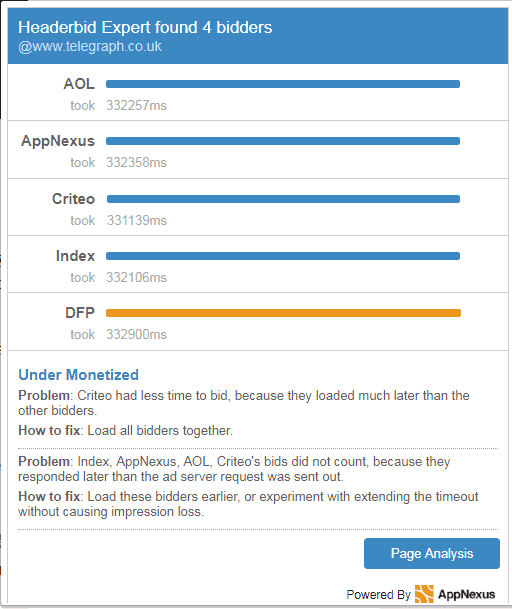
MonetizeMore’s Pubguru Header Bidder

Since MonetizeMore is an industry leader within the top header bidding providers list and publisher monetization platforms, we have been developing and implementing header bidding for publishers for 11 years. Our Header Bidding product that was formerly called MonetizeMore Demand has now evolved into an advanced header bidding wrapper platform called PubGuru.
With our Pubguru Header Bidding Platform, we’ve developed and integrated a range of ad optimization tech and tools while remaining transparent to our publishers. Here’s our product video explaining how simple it is to implement PubGuru on your website.
The PubGuru setup comes with a whole list of benefits such as:
- Being able to track performance and revenues via a single interface
- Free to join and implement
- 24/7 support for our dedicated group of skilled ad ops employees
- Bid scaling being supported with automated bid scaling in development
- Optimization of header bidding via bid scaling, frequency capping, viewability scaling
- 100% Transparency for publishers
- Hybrid header bidding upgrade options and much more
Find out more about MonetizeMore’s PubGuru header bidding platform here.
Now, what exactly is MonetizeMore Demand?
MonetizeMore Demand is a Header Bid Solution that transforms your ad stack into an unbiased auction environment. Competing for ad networks must engage in a cut-throat bidding war to win your ad inventory. Empowering publishers to earn the highest possible revenues, MonetizeMore Demand has consistently boosted publisher CPM’s from 30% – 50%.
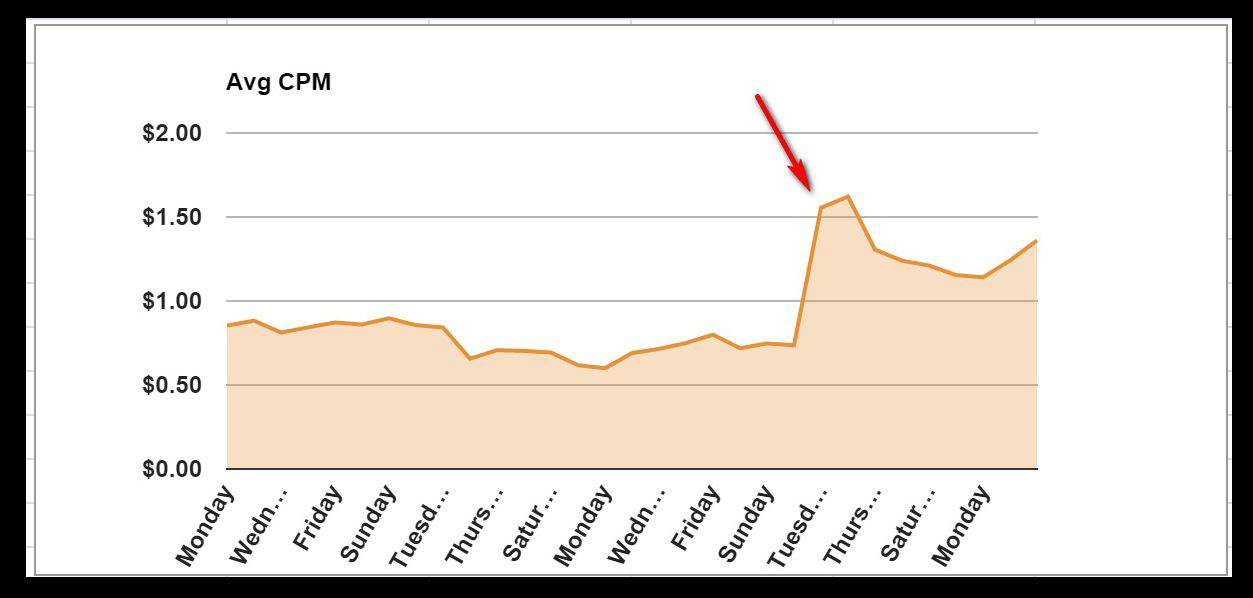
Case Study: 113% increase in Avg. CPM for Wuxiaworld.com after implementing MonetizeMore Demand.
Top demand sources bid for each ad impression at the exact CPM value that they pay within your GAM account. It’s just like Dynamic Allocation – but outside of Google!
Reap the benefits of the following:
- Gain eligibility to top ad networks (we leverage our existing relationships with 100s of ad networks on your behalf)
- Incremental RPM and revenue increases
- Ad revenue integration with Google Analytics
- Accurate revenue stats within Google Ad Manager
- 100% fill. No passbacks!
- Fewer unfilled ad impressions
- Network independence = unbiased auction environment
- No tech required: we implement the technology for you!
It’s a plug-and-play solution that pits warring ad factions against one another to drive up CPM’s and ensure each ad impression yields the highest possible revenues.
Stop selling your inventory for less than its worth. Try out the award-winning MonetizeMore Demand Header Bid Solution today!
Frequently Asked Questions
What is programmatic header bidding?
Publisher Inventory is auctioned through programmatic header bidding to multiple demand partners for greater yield and maximum ad revenue.
What is the difference between Prebid and Header Bidding?
Prebid is the open-source header bidding wrapper solution made to optimize the whole header bidding process.
What is the main difference between header bidding and the waterfall?
The main difference between header bidding and the waterfall is the auction process. In the waterfall, demand sources are prioritized based on a set hierarchy, with the highest-paying demand sources getting the first opportunity to bid. In header bidding, all demand sources have an equal opportunity to bid on each impression simultaneously.
Which method typically generates higher revenue for publishers, header bidding or the waterfall?
In general, header bidding has been shown to generate higher revenue for publishers compared to the waterfall, because it creates a more competitive environment for demand sources and allows publishers to monetize all available impressions.
Is header bidding more complicated to set up and manage than the waterfall?
Header bidding can be more complex to set up and manage compared to the waterfall, as it involves integrating multiple demand sources and configuring the auction process. However, there are tools and technologies available to simplify the process, such as header bidding wrappers and demand-side platforms (DSPs).
Can header bidding and waterfall be used together?
Yes, header bidding and the waterfall can be used together in a hybrid approach known as header bidding with fallback. This approach allows demand sources to bid on impressions through header bidding, but if no bid is received, the impression is passed to the waterfall.
Why should premium publishers use header bidding?
Header bidding can help premium publishers maximize revenue by creating a more competitive auction environment for their ad inventory and enabling them to monetize all available impressions.
How does header bidding differ from traditional programmatic advertising?
Unlike traditional programmatic advertising, which uses a waterfall auction system that prioritizes certain demand sources over others, header bidding allows all demand sources to bid on an impression at the same time, increasing competition and revenue potential.
How many demand sources should I include in my header bidding setup?
There is no one-size-fits-all answer to this question, as the optimal number of demand sources can vary depending on a variety of factors such as traffic volume, ad format, and audience demographics.
How do I measure the success of my header bidding setup?
Key performance indicators (KPIs) for measuring header bidding success may include revenue, fill rate, ad viewability, and user engagement.
How can I optimize my header bidding setup for better results?
Optimizing your header bidding setup may involve experimenting with different demand sources, adjusting ad formats and placements, and continually monitoring and analyzing performance data.
What are some potential risks associated with header bidding?
Some potential risks of header bidding include ad fraud, data leakage, and revenue cannibalization.
How can I mitigate risks associated with header bidding?
To mitigate risks associated with header bidding, it is important to implement measures such as fraud detection and prevention tools like Traffic Cop, data privacy policies, and careful monitoring and analysis of performance data.
source https://www.monetizemore.com/blog/what-is-header-bidding-guide/

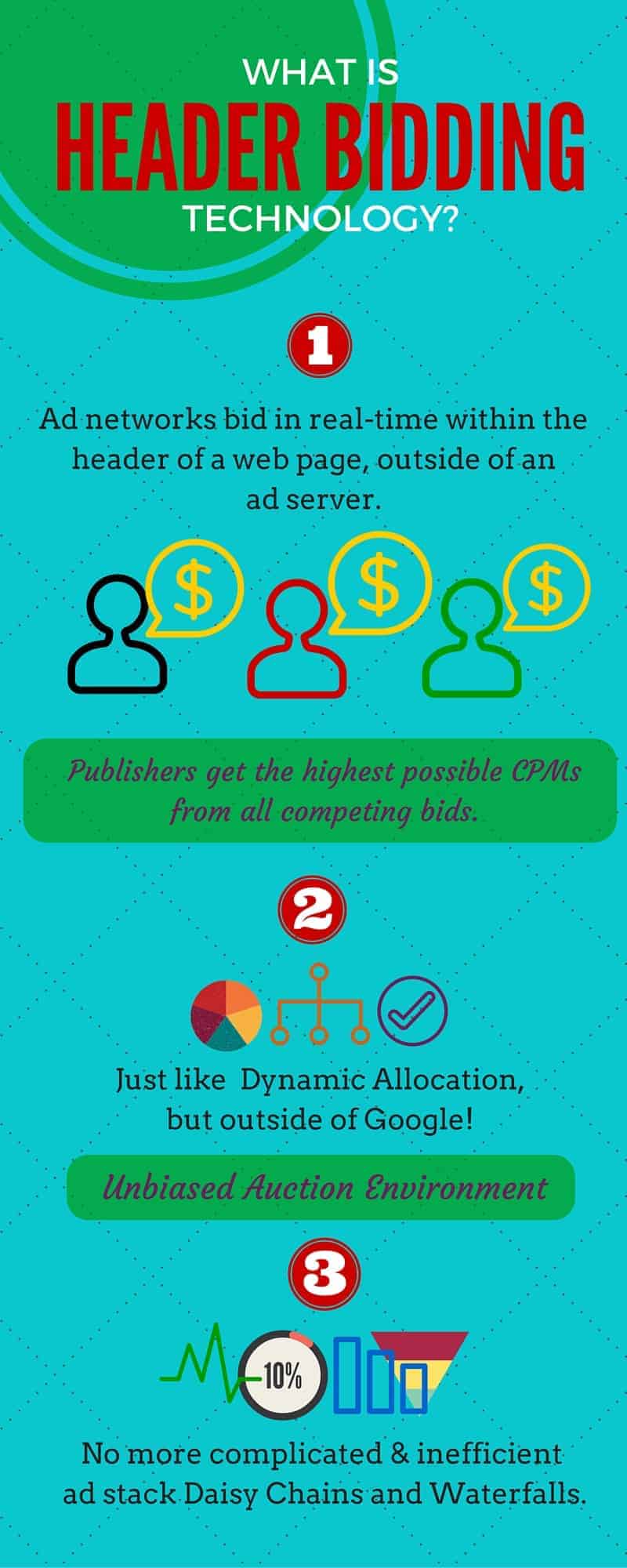
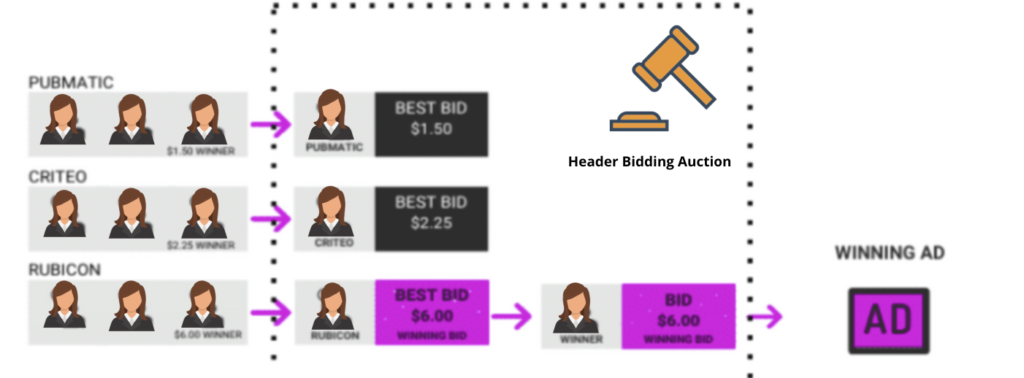


0 Comments